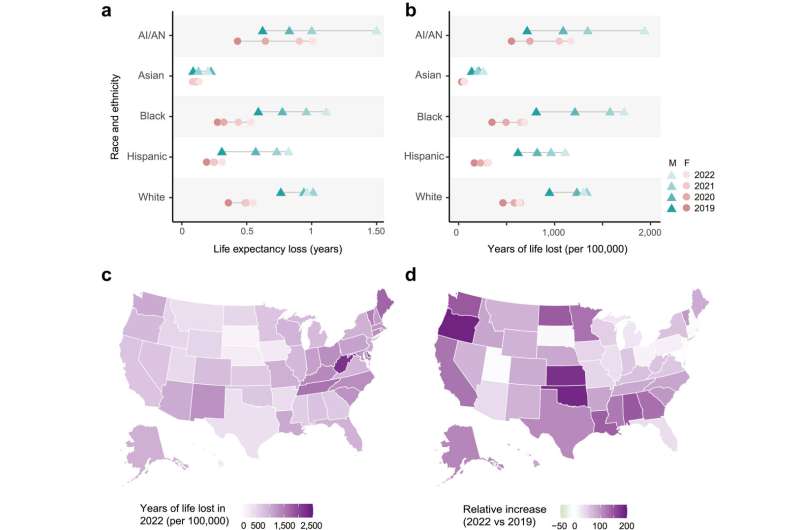This article has been reviewed according to Science X's editorial process and policies. Editors have highlighted the following attributes while ensuring the content's credibility:
fact-checked
trusted source
proofread
Fatal opioid overdoses reduce US life expectancy by nearly a year

In the early years of the COVID-19 pandemic, opioid-related deaths cut the nation's average life expectancy at birth by eight months, according to new research published in The Lancet Regional Health–Americas. The findings also suggest that young minorities bore the brunt of this crisis, with overdose deaths nearly doubling for Blacks, Hispanics, and American Indian/Alaska Natives in the past few years.
Alison Hill, an assistant professor of biomedical engineering at Johns Hopkins University, and postdoctoral researcher Anne H. Hébert said the study provides important insights into how the opioid epidemic has evolved since the onset of COVID-19, which disrupted people's support systems, economic stability, and access to health care.
The researchers found that, in 2022 alone, more than 80,000 of the 3.3 million deaths that occurred in the United States were caused by opioid-related overdoses. These deaths predominantly affected young adults: Compared to the average U.S. life expectancy at that time, those who died from opioid overdoses lost an average of 38 years of life.
"Just the number of deaths alone hardly captures the enormous burden of the opioid crisis on this country," said Hill, the study's senior author. "These are people in their 20s and 30s who aren't close to the end of their lives—it's really taking away a huge number of potential years where they could have lived and contributed to society."
The pair used publicly available mortality data from the CDC's National Center for Health Statistics, Hébert explained, to analyze the demographic characteristics of every individual in the United States who died of an opioid-related overdose between 2019 and 2022.
They developed a method to calculate both the impact of these deaths on the nation's overall life expectancy and the individual years of life lost by each victim, defined as the difference between a person's age at death and their expected lifespan.
Their analysis confirmed that the demographics of those dying from opioids shifted notably as the pandemic progressed: What was once viewed as a "rural white problem" was seeping into other racial and ethnic communities at an alarming rate, they found.
"What this tells us is that we need to start addressing the factors that may be contributing to opioid abuse in all types of communities," Hill said.
The data revealed another worrisome trend: "polysubstance" overdoses, or overdoses that involve more than one drug, made up about half of opioid-related deaths. During the study period, people died from a combination of opioids and stimulants like methamphetamine and cocaine. Hill noted that polysubstance overdoses are more difficult to treat and thus more fatal, further complicating an already out-of-control epidemic.
The team said that its findings are based on the most up-to-date mortality data available from the CDC. The researchers have made their analyses available through a public dashboard that allows non-experts to explore how this burden varies across geographical locations, ages, genders, and racial and ethnic groups. They will continue to update the dashboard as new mortality data is released for 2023 and the following years.
"We want to raise awareness of how the problem is spreading and the devastating impact opioid addiction is having on the country," Hébert said. "Someone can click through the dashboard and see what is happening in their state or community, or how the numbers have changed over the years. It makes the science more accessible to everyone."
So where do we go from here? Data can point us in the right direction, Hill said.
"Given these trends, it's important to arm public health officials and policymakers with more comprehensive data so they can develop strategies to bring down the number of opioid-related deaths," she said.
And they must act quickly, the researchers added.
"Looking at specific groups affected, specific regions affected, and specific drug combinations gives a much more detailed picture of how we need to target this crisis, which is only getting worse with time," Hill said.
Moving forward, Hill and Hébert plan to explore other data trends that may shed light on the crisis, such as non-fatal overdoses, that could be investigated but are not currently captured in any nationally-representative or widely-accessible databases.
More information: Anne H. Hébert et al, Impact of opioid overdoses on US life expectancy and years of life lost, by demographic group and stimulant co-involvement: a mortality data analysis from 2019 to 2022, The Lancet Regional Health–Americas (2024). DOI: 10.1016/j.lana.2024.100813

















